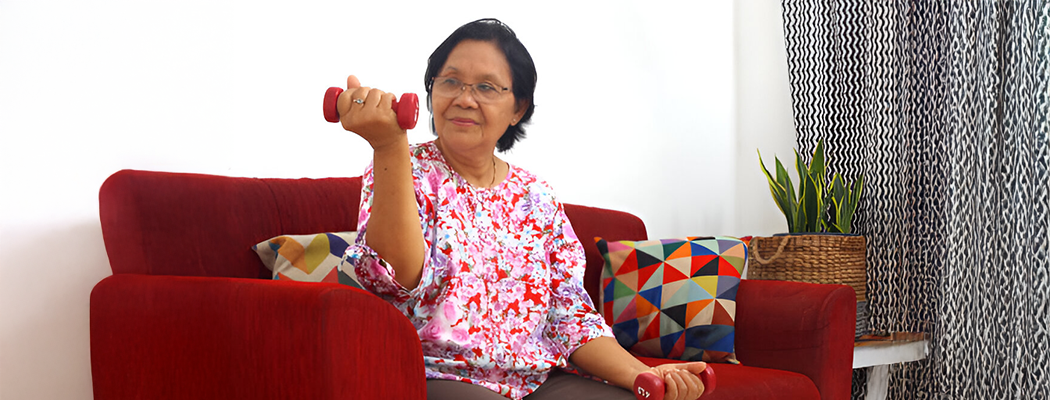
Friday, 24 January, 2025
Introduction
Living with rheumatoid arthritis (RA) can be challenging, especially when your daily activities are impacted by pain and stiffness. Although medication is necessary to manage symptoms, incorporating gentle rheumatoid arthritis exercises at home into your daily routine may significantly boost joint flexibility, reduce stiffness, and enhance overall mobility.
Often patients explore simple exercises that are safe to perform at home. These exercises are designed to complement your treatment plan, but it’s important to remember that every patient’s condition is unique. Always consult your doctor or a rheumatologist to follow proper rheumatoid arthritis exercise guidelines and avoid any movements that may worsen symptoms.
Here are eight doctor-recommended exercises that can help manage RA symptoms effectively.
8 Exercises for Rheumatoid Arthritis
1. Wrist Rolls
Wrist joints often bear the brunt of RA-related stiffness. Simple wrist rolls can enhance flexibility.
- How it helps: Gentle movements improve circulation and reduce stiffness, making daily tasks like writing or typing easier.
- How to do it: Extend your arms and rotate your wrists in slow, controlled circles. Repeat in both directions.
2. Finger Stretches
Finger stiffness can interfere with tasks like holding objects or typing. Finger stretches can help maintain dexterity.
- How it helps: Enhances joint flexibility and strengthens finger muscles.
- How to do it: Open your hand wide, stretch your fingers apart, then relax. Repeat 10 times daily.
3. Shoulder Rolls
RA can cause discomfort in the shoulders, restricting arm movements.
- How it helps: Shoulder rolls loosen stiff muscles and improve joint range of motion.
- How to do it: Roll your shoulders forward in circular motions for 10 repetitions, then reverse the direction.
4. Ankle Rotations
For patients experiencing ankle stiffness, rotations can be incredibly effective.
- How it helps: Reduces swelling, improves joint flexibility, and strengthens surrounding muscles.
- How to do it: Sit on a chair, lift one foot, and rotate your ankle in a circular motion. Repeat for both ankles.
5. Seated Leg Lifts
This is a low-impact exercise to strengthen muscles around the knee.
- How it helps: Supports knee joints and enhances stability.
- How to do it: While seated, extend one leg forward, hold for 5 seconds, then lower it. Switch legs and repeat.
6. Neck Stretches
Stiffness in the neck is common in RA and can lead to discomfort.
- How it helps: Reduces tension and improves range of motion.
- How to do it: Tilt your head gently toward one shoulder, hold for 10 seconds, and switch sides
7. Cat-Cow Stretch
A yoga-based stretch, this is beneficial for spinal health and overall flexibility.
- How it helps: Relieves back stiffness and strengthens core muscles.
- How to do it: On all fours, alternate between arching your back (cat pose) and lifting your head while lowering your belly (cow pose). Repeat 10 times.
This is among the best exercises for rheumatoid arthritis for improving spinal health.
8. Hand Squeezes with a Stress Ball
This simple exercise strengthens grip and reduces finger stiffness.
- How it helps: Improves hand strength and dexterity.
- How to do it: Hold a soft stress ball and squeeze it gently for 5 seconds. Repeat 10 times with each hand.
Tips for Exercising with Rheumatoid Arthritis
When managing RA, exercise is important, but safety comes first. Keep these tips in mind:
- Start Small: Begin with gentle movements and gradually increase intensity.
- Stay Consistent: Regular exercise helps maintain mobility and manage pain.
- Listen to Your Body: Can exercise trigger rheumatoid arthritis symptoms? Overexertion might. Stop if you experience unusual pain.
- Avoid High-Impact Activities: Stick to low-impact movements and follow rheumatoid arthritis exercise guidelines.
- Consult Your Rheumatologist: For advanced cases, a rheumatologist in Bangalore can tailor an exercise plan or suggest alternatives like physical therapy or joint replacement surgery for joint pain.
Conclusion
Exercise is an integral part of a comprehensive rheumatoid arthritis management plan. By incorporating these simple exercises into your daily routine, you can improve joint function, reduce stiffness, and enhance overall quality of life.
However, exercise alone isn’t enough. Combining these movements with a rheumatoid arthritis diet and exercise plan can deliver better results. Always prioritize rheumatoid arthritis and exercise precautions to avoid unnecessary strain on your joints.
If you’re unsure where to begin, consult a rheumatologist or physiotherapist
FAQs
1. Can rheumatoid arthritis cause balance problems?
Yes, rheumatoid arthritis can cause balance problems due to joint pain, inflammation, and muscle weakness. These factors may affect stability, making regular strengthening and balance exercises crucial.
2. What foods should I avoid in rheumatoid arthritis?
Foods high in sugar, saturated fats, trans fats, and refined carbohydrates can trigger inflammation and worsen RA symptoms. Limit processed foods and focus on a balanced, anti-inflammatory diet.
3. What is the latest treatment for rheumatoid arthritis?
The latest treatments for rheumatoid arthritis include biologics and JAK inhibitors, which target specific components of the immune system to reduce inflammation and slow disease progression.
4. How can I decrease joint pain naturally?
To decrease joint pain naturally, maintain an anti-inflammatory diet, practice gentle exercises, manage stress, and apply heat or cold therapy to soothe affected joints.
Author Doctor Name
Dr Pradeep R Kumar
Senior Consultant - Rheumatology
MBBS MRCP MD


 Neurosciences
Neurosciences Bariatric Surgery
Bariatric Surgery